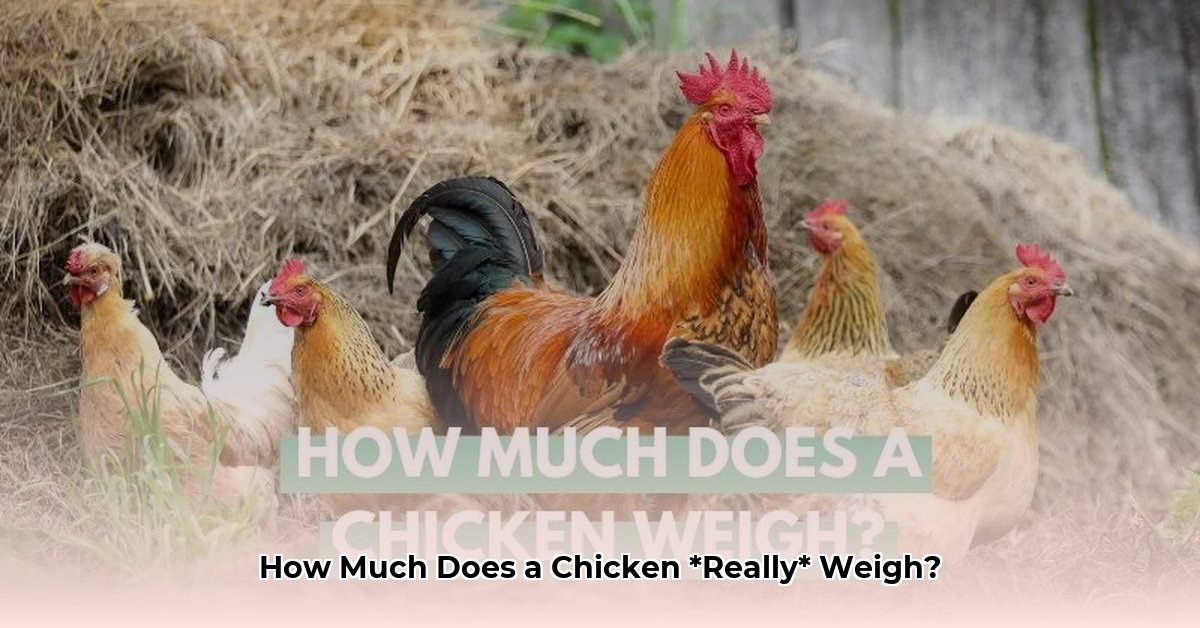Ever wonder how much a chicken weighs? Well, it depends! Just like dogs range from Chihuahuas to Great Danes, chickens vary from petite bantams to hefty Brahma roosters. Generally, you can expect a chicken to weigh anywhere from one to thirteen pounds. This guide will cover everything you need to know about chicken weights, from breed specifics to how to weigh your own flock.
Factors Affecting Chicken Weight
A chicken’s weight is influenced by several key factors:
Breed
Just like different dog breeds have distinct size ranges, chicken breeds significantly impact weight. Brahmas, for example, are known for their large size, while Leghorns are considerably lighter.
Sex
Roosters (males) are typically larger and heavier than hens (females) of the same breed. This difference is often noticeable, even in younger birds.
Age
Chicks, naturally, weigh far less than adult chickens. Growth rates also vary by breed, with meat birds (broilers) developing much faster than laying hens.
Purpose
Meat chickens, or broilers, are selectively bred for rapid weight gain, resulting in much larger birds compared to laying hens, which are bred for egg production. Dual-purpose breeds aim for a balance between meat and egg production, leading to moderate weights.
Chicken Weight by Breed
The following table provides average weights for common chicken breeds. Remember, individual birds can vary due to genetics, diet, and other factors.
| Breed | Rooster (lbs) | Hen (lbs) | Bantam Rooster (lbs) | Bantam Hen (lbs) |
|---|---|---|---|---|
| Rhode Island Red | 8.5 | 6.5 | 3 | 2.5 |
| Plymouth Rock | 9.5 | 7.5 | 3.5 | 3 |
| Wyandotte | 8 | 6 | 3 | 2.5 |
| Orpington | 10 | 8 | 3.5 | 3 |
| Leghorn | 6 | 4.5 | 2 | 1.5 |
| Cochin | 11 | 8.5 | 2 | 1.5 |
| Brahma | 12 | 9.5 | – | – |
| Jersey Giant | 13 | 10 | – | – |
| Silkie | 3.5 | 2.5 | 1.5 | 1 |
| This chart represents average weights. Individual birds can vary. |
Bantam Chickens vs. Standard Chickens
Bantam chickens are essentially miniature versions of standard breeds, often weighing a quarter to a third of their larger counterparts. They are a popular choice for backyard flocks with limited space. For example, a standard Rhode Island Red might weigh 6.5 lbs, while a bantam Rhode Island Red likely weighs closer to 2 lbs.
Dressed Chicken Weight
A “dressed” chicken (feathers and internal organs removed) typically weighs 3-5 pounds in the grocery store. This is significantly less than its live weight. A 5-pound dressed chicken probably weighed around 8-9 pounds alive. The dressed weight typically represents around 60-75% of the bird’s live weight.
How to Weigh a Live Chicken
Here are two simple methods using a household scale:
Method 1: The Container Method
- Place your chicken gently into a container like a box, pet carrier, or basket.
- Place the container on the scale and note the combined weight.
- Remove the chicken and weigh the empty container.
- Subtract the container’s weight from the combined weight to get the chicken’s weight.
Method 2: The Towel Wrap
- Gently wrap your chicken in a towel to keep it calm and prevent flapping.
- Use a hanging scale to suspend the wrapped chicken and read the weight. Alternatively, place the wrapped chicken on a platform scale.
Broiler Chicken Growth: A Historical Perspective
Interestingly, broiler chickens today are significantly larger than they were decades ago due to selective breeding and nutritional advances. This increase in size raises considerations about animal welfare and sustainable farming practices. Research into optimal broiler weights and growth rates continues, with an emphasis on balancing production efficiency and ethical considerations.
Addressing Weight Issues
If your chicken appears significantly underweight or overweight, consult a poultry veterinarian. Various factors, from dietary imbalances to underlying health conditions, can contribute to weight problems. A veterinarian can provide a proper diagnosis and recommend appropriate action.
Ongoing Research and Evolving Knowledge
Research on chicken health and nutrition is ongoing. The information presented here reflects current understanding, but ongoing studies may refine ideal weight ranges and best practices. Staying informed about the latest findings from reputable sources like poultry science journals and agricultural extension services is beneficial for responsible chicken keeping.
Conclusion
As you’ve seen, a chicken’s weight is a complex topic influenced by various factors. From bantams to jumbo breeds, understanding weight ranges can help you better care for your flock. This guide provides a solid foundation for estimating chicken weights, but remember that individual variations are normal. By considering breed, sex, age, and purpose, you can better understand and manage your chickens’ health and well-being. If you have questions or observations about your own chickens’ weights, don’t hesitate to share them in the comments below!
- Weight Loss Supplements That Work and Those That Dont - October 31, 2025
- Male Eating Disorders Often Missed but Increasingly Prevalent - October 29, 2025
- Males With Anorexia Nervosa Have Distinct Symptoms and Treatment Needs - October 28, 2025










